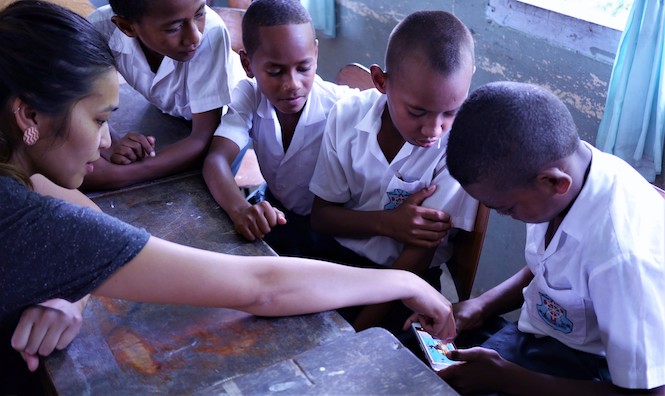Future Now
The IFTF Blog
Virtual Reality and Storytelling for More than Entertainment
A few months ago I spent about sixty seconds trapped under a fallen rafter in a burning building. As I lay there on the floor, waves of heat wafting over my body, my colleague explained how sensory cues - the fake crackling fire sounds, the heat from the portable space heater, the weight of a folding table across my chest - all contributed to a more immersive experience. I was, of course, not stuck in a real fire, but in virtual reality. And while the experience didn’t quite trick me into thinking I was in danger, it stuck with me. I think about it every now and then in the same way that I recall a memory - in my mind I was there, in a burning building, unable to get out.
This is the key to the power of VR. Even at a pretty low resolution, with a narrow field of vision, and a vine-like cable dangling off the back of your headset, you process it as a real experience. Which means that it opens the doors to a deeper level of communication - instead of simply talking about or showing pictures of an experience, you can let people live it themselves.
So far, VR has opened up some pretty fun new possibilities. Mobile VR has taken bargoers on tours of the Scottish highlands, put schoolkids on the moon, and given grandma a chance to ride a rollercoaster. More powerful systems have seen a quick rise in incredibly immersive games and experiences. The value of VR as an entertainment system is undeniable.
But the full range of what we can do with the technology is still in tantalizingly-untrodden territory. A handful of startups are scrambling to use VR for more than entertainment - it has potential applications in physical therapy, psychological treatment, and education. As the hardware improves, the range of applications will grow far beyond these.

To that end, Legends is an immersive food and nutrition storytelling project in the schools of Tonga and Fiji using VR beyond just creating a piece of entertainment media. The idea is that a thoughtfully-planned series of immersive experiences can teach children about traditional (and less industrially processed) foods, and in turn get them excited about healthier ways of eating. Unlike educational VR apps that essentially present traditional teaching environments, just in virtual reality, Legends introduces a new mode of teaching. Just like I remember the vivid experience of being in a burning building, can kids carry the positive experiences they encounter with traditional foods in VR over to their real lives?

The outcomes of the project will be a big indicator of how this signal might scale up. If VR proves to be an effective way to promote healthy behavior change, there are countless communities across the world that could benefit. As a critical part of Launch, stakeholders include local community activists, food industry professionals, and local artists, as well as the communities at large. As we see more experimentation in the applications of VR beyond entertainment, community buy-in will be critical for success.
Most importantly, Legends isn’t an experiment or a top-down solution. It’s a fully earnest attempt to solve an immediate problem - poor nutrition due to diet behavior - that has persisted despite more traditional attempts at a solution. Small nations like Fiji and Tonga are microcosms of the food systems of larger countries, including the U.S., so understanding if and how immersive storytelling impacts nutrition outcomes has tremendous potential impact.
Legends is a partnership between the Australian Department of Foreign Affairs and Trade's InnovationXchange, SecondMuse, the creative technology companies S1T2, Millipede based in Australia, and the communities of Fiji and Tonga. Senior Advisors include emerging technologists Davar Ardalan and Bein Kreimer. More information can be found here.
Photography by Ben Kreimer.



